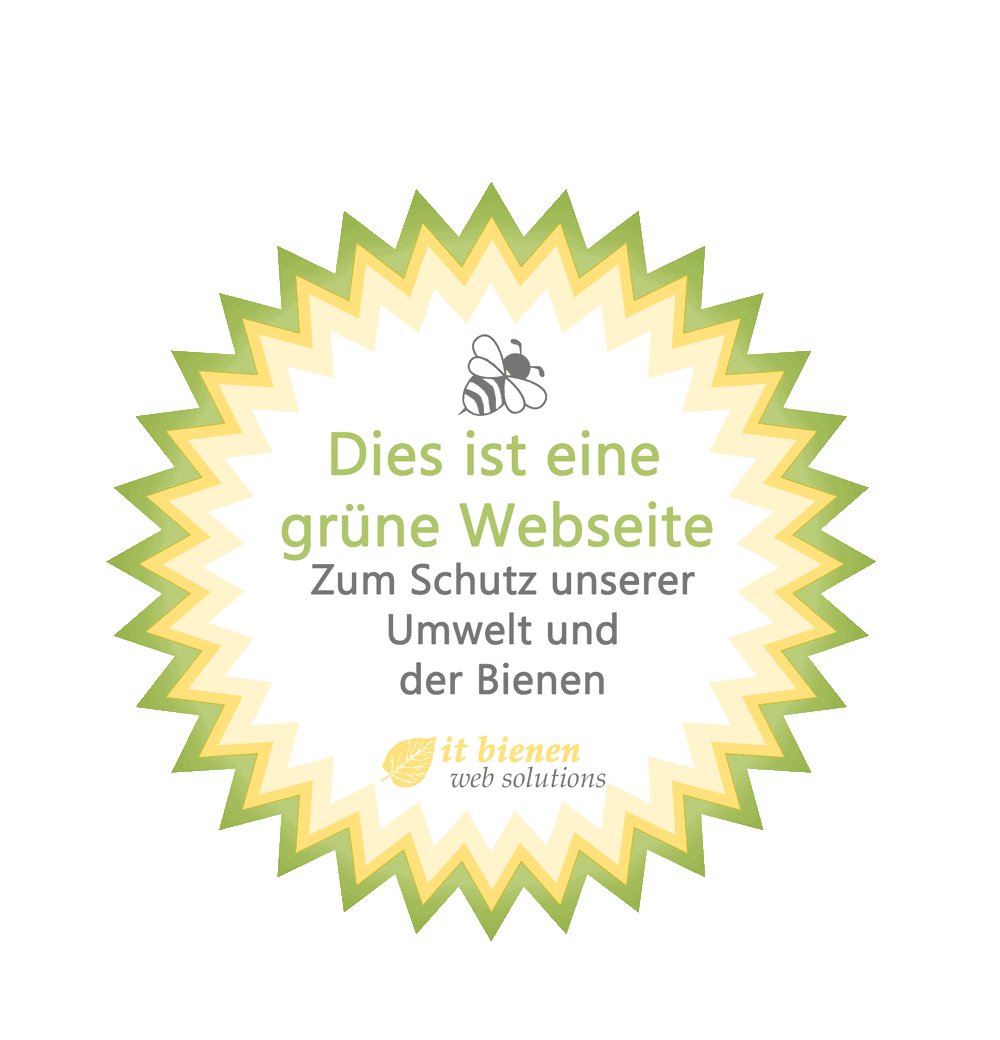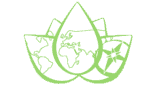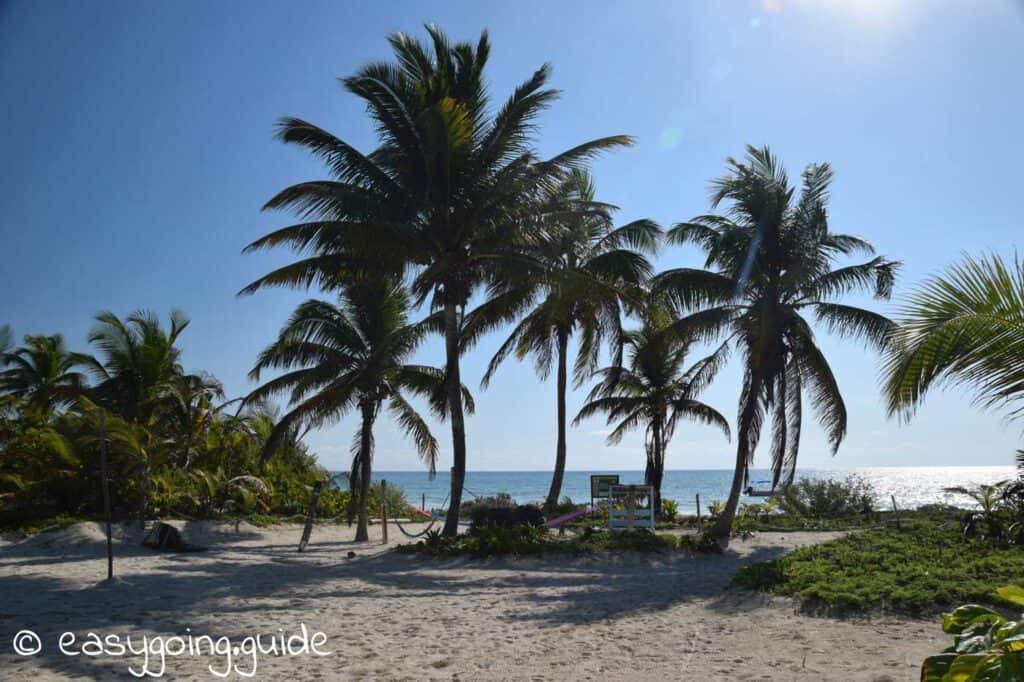Every  morning I wake up, listen to the sound of the sea, taste the salt of the cool sea breeze in the air and realize again: Yes, I am currently living in paradise. A life on the beach. In the simplest conditions, you can imagine. That’s everything I need to be happy. Anyhow, a dark cloud hangs over this wonderful world. Every day I see the negative influence of humans on our environment. I am here, in the middle of a nature reserve, as a participant in a marine conservation project. We are here to help. To make a difference. Trying to make the world a little bit better. In this article, I’ll tell you what exactly we are doing here in the camp.
morning I wake up, listen to the sound of the sea, taste the salt of the cool sea breeze in the air and realize again: Yes, I am currently living in paradise. A life on the beach. In the simplest conditions, you can imagine. That’s everything I need to be happy. Anyhow, a dark cloud hangs over this wonderful world. Every day I see the negative influence of humans on our environment. I am here, in the middle of a nature reserve, as a participant in a marine conservation project. We are here to help. To make a difference. Trying to make the world a little bit better. In this article, I’ll tell you what exactly we are doing here in the camp.
The marine conservation project
The 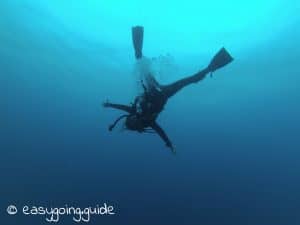 project I’m participating in is a volunteer project organized by GVI. This is one of the world’s largest volunteer organizations. GVI offers a variety of different projects around the globe, not just in the field of marine conservation. I opted for one with the title “Marine Conservation and PADI Divemaster Internship.” With the focus on marine protection, I’m also expanding my dive training at the same time right up to Divemaster. Yes, I had to pay a lot of money for it and if I just wanted to do my divemaster training, I could certainly have made it cheaper somewhere else. But I want to make a difference and gain some knowledge in the field of marine conservation. That’s why I decided to participate in this project. For me, it’s worth the money.
project I’m participating in is a volunteer project organized by GVI. This is one of the world’s largest volunteer organizations. GVI offers a variety of different projects around the globe, not just in the field of marine conservation. I opted for one with the title “Marine Conservation and PADI Divemaster Internship.” With the focus on marine protection, I’m also expanding my dive training at the same time right up to Divemaster. Yes, I had to pay a lot of money for it and if I just wanted to do my divemaster training, I could certainly have made it cheaper somewhere else. But I want to make a difference and gain some knowledge in the field of marine conservation. That’s why I decided to participate in this project. For me, it’s worth the money.
Where do we live
Our base 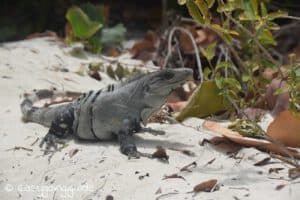 is in the middle of the Sian Ka’an Reserve, south of Tulum on the Yucatan Peninsula in Mexico. Secluded from almost any civilization we live in the simplest of conditions. We have no running water, only limited solar power, no internet, but are closely connected with nature – a life that is hardly imaginable in today’s society. To tell the truth, these conditions are worth gold here. It shows me clearly what many people have seemed to forget: you can be happy with barely nothing. It’s not important to have the latest phone or the hottest car. The cohabitation and the actions that we carry out in favour of our blue planet are worth a thousand times more.
is in the middle of the Sian Ka’an Reserve, south of Tulum on the Yucatan Peninsula in Mexico. Secluded from almost any civilization we live in the simplest of conditions. We have no running water, only limited solar power, no internet, but are closely connected with nature – a life that is hardly imaginable in today’s society. To tell the truth, these conditions are worth gold here. It shows me clearly what many people have seemed to forget: you can be happy with barely nothing. It’s not important to have the latest phone or the hottest car. The cohabitation and the actions that we carry out in favour of our blue planet are worth a thousand times more.
The everyday camp madness
The alarm rings 5:45. I get up, get dressed and then I have half an hour to go to the “gym”. It consists of a pull-up bar and a homemade wooden bar – not much, but enough to do a few exercises. Yoga, bodyweight sessions, sprints or meditation are on my daily program before the day starts properly. From 6.30 on we have to do camp duties. Depending on the day, these consist of cleaning communal area, raking the beach, loading boats or cooking for everyone. Everyone will help for half an hour before breakfast starts. After breakfast, before the first diving wave starts,
rings 5:45. I get up, get dressed and then I have half an hour to go to the “gym”. It consists of a pull-up bar and a homemade wooden bar – not much, but enough to do a few exercises. Yoga, bodyweight sessions, sprints or meditation are on my daily program before the day starts properly. From 6.30 on we have to do camp duties. Depending on the day, these consist of cleaning communal area, raking the beach, loading boats or cooking for everyone. Everyone will help for half an hour before breakfast starts. After breakfast, before the first diving wave starts, 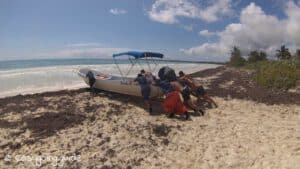 we bring the boats into position. We do this just with our muscle power. In total there are up to 4 waves for diving daily. Two of them are done before noon from 8-12 o’clock. The other two take place in the afternoon from 1 pm to 5 pm. In each wave, two boats go out. These are loaded with mostly 6 divers + Captain. We as volunteers have 1-2 dives a day and are therefore 2 waves on base. During this time we work on projects, learn for our training or scientific dives, do the radio for the boats, cook for the base or fill the tanks on the compressor. You see, there is always plenty of stuff to do. Sometimes it is even so much that good time management is needed. Once all the diving waves have been completed, we push the boats back
we bring the boats into position. We do this just with our muscle power. In total there are up to 4 waves for diving daily. Two of them are done before noon from 8-12 o’clock. The other two take place in the afternoon from 1 pm to 5 pm. In each wave, two boats go out. These are loaded with mostly 6 divers + Captain. We as volunteers have 1-2 dives a day and are therefore 2 waves on base. During this time we work on projects, learn for our training or scientific dives, do the radio for the boats, cook for the base or fill the tanks on the compressor. You see, there is always plenty of stuff to do. Sometimes it is even so much that good time management is needed. Once all the diving waves have been completed, we push the boats back 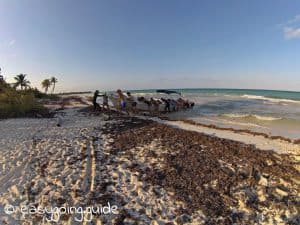 onto the beach. With a bit of luck, there will be some time left for a running session before it’s already dinner time. Afterwards, the program of the next day will be discussed, we learn our science stuff, work or relax together. So far this may sound like a normal day at home. You might wonder where exactly the marine conservation is taking place right now. Did I catch you? I’d like to answer this question: the dives of the marine conservation project are crucial.
onto the beach. With a bit of luck, there will be some time left for a running session before it’s already dinner time. Afterwards, the program of the next day will be discussed, we learn our science stuff, work or relax together. So far this may sound like a normal day at home. You might wonder where exactly the marine conservation is taking place right now. Did I catch you? I’d like to answer this question: the dives of the marine conservation project are crucial.
Diving for the protection of the sea
Since our program 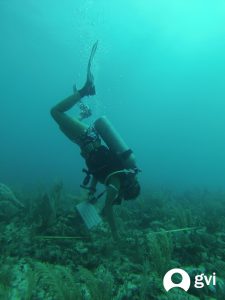 is dedicated to marine conservation, our dives are mainly of scientific nature. The goal is to train up volunteers to be able to collect data about the reef. This data will provide information about the health of the reef. It will be transmitted to our partners and can help decision-makers in protecting the reefs. In order to collect reliable data, several weeks of training are required. Therefore we need to do various theory units as well as training dives. In total, the process consists of up to 7 stages, including all tests underwater and on land. Only when the number of levels corresponding to the training has been passed you are officially admitted to the data collection. Then you may do special dives for data collection.
is dedicated to marine conservation, our dives are mainly of scientific nature. The goal is to train up volunteers to be able to collect data about the reef. This data will provide information about the health of the reef. It will be transmitted to our partners and can help decision-makers in protecting the reefs. In order to collect reliable data, several weeks of training are required. Therefore we need to do various theory units as well as training dives. In total, the process consists of up to 7 stages, including all tests underwater and on land. Only when the number of levels corresponding to the training has been passed you are officially admitted to the data collection. Then you may do special dives for data collection.
Coral Watch
In addition  to this extensive training, there are several other types of dives that we carry out in the marine conservation project. First, so-called Coral Watch dives. Coral Watch is a worldwide coral bleaching data collection set up by Australian scientists to monitor, analyze and compare reef health worldwide. Over the years, the marine conservation project has become the 3rd largest data collector worldwide for Coral Watch. Armed with colour chard and previously learned knowledge, we identify the coral and can make statements about the progress of coral bleaching. We then submit this data.
to this extensive training, there are several other types of dives that we carry out in the marine conservation project. First, so-called Coral Watch dives. Coral Watch is a worldwide coral bleaching data collection set up by Australian scientists to monitor, analyze and compare reef health worldwide. Over the years, the marine conservation project has become the 3rd largest data collector worldwide for Coral Watch. Armed with colour chard and previously learned knowledge, we identify the coral and can make statements about the progress of coral bleaching. We then submit this data.
Dive against debris
In addition to the dives for data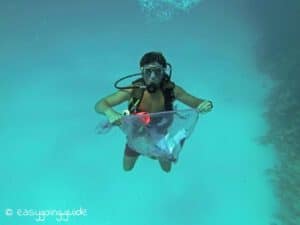 collection, we also collect garbage during special dives. These are called “Dive against Debris”. They were created by our partner Project AWARE. During these dives, we devote the entire dive time to collect as much garbage as possible
collection, we also collect garbage during special dives. These are called “Dive against Debris”. They were created by our partner Project AWARE. During these dives, we devote the entire dive time to collect as much garbage as possible  from the reefs. Especially plastic bags and cords that have already caught on corals can be found again and again. It is so sad to see a half dead coral due to the garbage that has caught on it. Every time I see something like this it breaks my heart.
from the reefs. Especially plastic bags and cords that have already caught on corals can be found again and again. It is so sad to see a half dead coral due to the garbage that has caught on it. Every time I see something like this it breaks my heart.
The hunt for the lionfish
Another aspect of 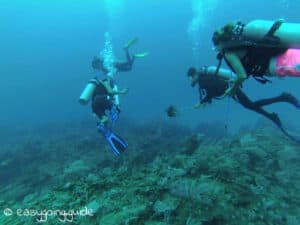 our dives is the killing of lionfish. You certainly know this fish species from aquariums: striped brown and white, it therefore floats as if it had feathers. A wonderful fish, if you ask me. Anyhow, unfortunately, it can do a lot of damage as well. After Hurricane Andrew, 6 of these specimens were released into the sea in 1992 from destroyed aquariums in Florida. Since then they have been spread invasively. Normally, they do not actually occur in these latitudes. That’s why they don’t have natural enemies here. For this reason, they have been able to multiply undisturbed at breakneck speed. Now they destroy the original balance in the reef, feeding on juvenile fish and greatly depleting their stock. To be honest, at first I found it very difficult to hunt these animals. It took me weeks to try my first attempt. But just as the forest ranger has to kill some animals in the forest in order to keep their balance, we have to do the same here, just in the water.
our dives is the killing of lionfish. You certainly know this fish species from aquariums: striped brown and white, it therefore floats as if it had feathers. A wonderful fish, if you ask me. Anyhow, unfortunately, it can do a lot of damage as well. After Hurricane Andrew, 6 of these specimens were released into the sea in 1992 from destroyed aquariums in Florida. Since then they have been spread invasively. Normally, they do not actually occur in these latitudes. That’s why they don’t have natural enemies here. For this reason, they have been able to multiply undisturbed at breakneck speed. Now they destroy the original balance in the reef, feeding on juvenile fish and greatly depleting their stock. To be honest, at first I found it very difficult to hunt these animals. It took me weeks to try my first attempt. But just as the forest ranger has to kill some animals in the forest in order to keep their balance, we have to do the same here, just in the water.
Marine protection ashore
Marine protection 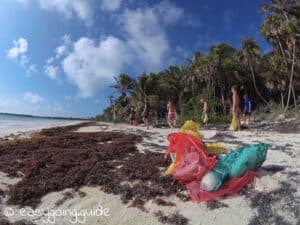 does not start in the water but starts with our daily decisions like plastic consumption or waste separation. For this reason, we try to increase the awareness of the volunteers in the camp. In addition to presentations, lessons and discussions, we also start fundraising campaigns and carry out beach cleanups once a week. Armed with garbage bags, we make our way to the beach and collect all the garbage on a 100-200m section that comes between us.
does not start in the water but starts with our daily decisions like plastic consumption or waste separation. For this reason, we try to increase the awareness of the volunteers in the camp. In addition to presentations, lessons and discussions, we also start fundraising campaigns and carry out beach cleanups once a week. Armed with garbage bags, we make our way to the beach and collect all the garbage on a 100-200m section that comes between us. 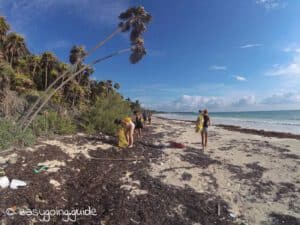 Especially different sizes of plastic parts are always found in large quantities. But also toys, cosmetics or even car parts have already found their way into our hands. All in all, we collected almost 500kg of garbage in the first 8 weeks of my stay. And daily, new amounts of garbage are washed up. It’s scary.
Especially different sizes of plastic parts are always found in large quantities. But also toys, cosmetics or even car parts have already found their way into our hands. All in all, we collected almost 500kg of garbage in the first 8 weeks of my stay. And daily, new amounts of garbage are washed up. It’s scary.
What we all can do against the waste
I know that the garbage is not from you or from me, yet we should all try to limit the amount of garbage we create. Have a look at my articles 10 simple tips for avoiding plastic waste and 10 tips on how to avoid packaging waste. Let’s move things together. Your daily decisions count as well.
Make a difference together!
What have you already done today to protect the environment? Or do you protect it every day? Let me know.


